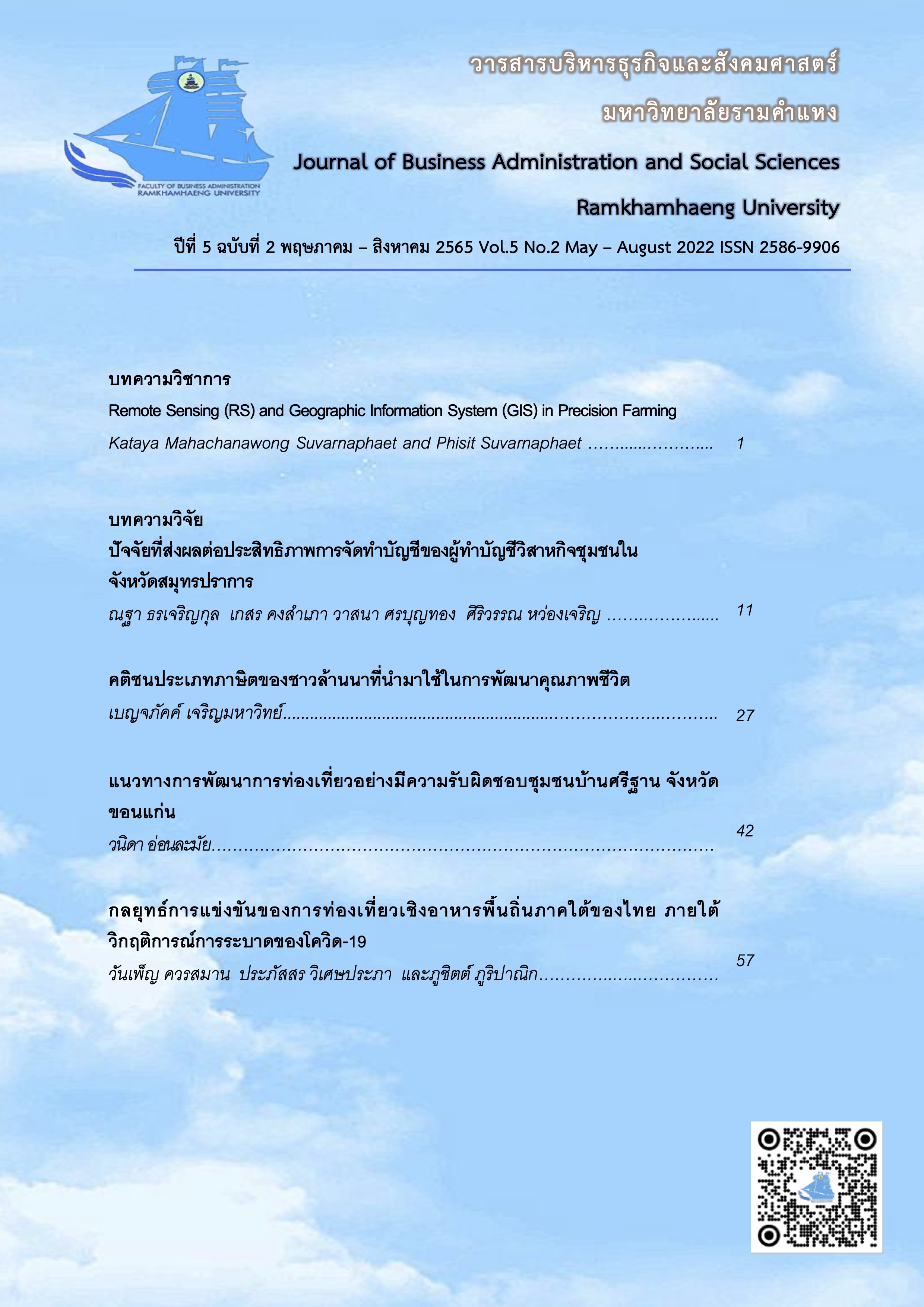Lanna Proverb Folklore Used for Improving the Quality of Life
Main Article Content
Abstract
In this research investigation, the researcher examines the folklore of the type of Lanna proverbs used for improving the quality of life. The study was conducted using the techniques of documentary research and in-depth interview with five knowledgeable persons or local wisemen.
Findings show that Lanna proverb folklore is influenced by belief, faith, and the engagement that Lanna people have towards Buddhism. Buddhist preachings continue to be deeply rooted in the souls of Lanna people. Buddhist principles reflect the proverbs Lanna people adhere to and tightly practice. Lanna proverbs used for improving the quality of life are in the following four aspects. 1) Proverbs used for improving attitudes, understanding the world, and rational thinking consist of 239 proverbs. 2) Proverbs used for improving living conditions, skills, and wisdom consist of 125 proverbs. 3) Proverbs used for improving social relations, personality, adaptation, public mind, beliefs, creeds, and religion consist of 84 proverbs. 4) Proverbs used for improving identity, preserving traditions, culture, language, conserving antiques, and pride in self-identity consist of 53 proverbs.
Article Details

This work is licensed under a Creative Commons Attribution-NonCommercial-NoDerivatives 4.0 International License.
เนื้อหาและข้อมูลในบทความที่ลงตีพิมพ์ในวารสารบริหารธุรกิจและสังคมศาสตร์ มหาวิทยาลัยรามคำแหง ถือเป็นข้อคิดเห็นและความรับผิดชอบของผู้เขียนบทความโดยตรง ซึ่งกองบรรณาธิการไม่จำเป็นต้องเห็นด้วย หรือร่วมรับผิดชอบใดๆ
บทความ ข้อมูล เนื้อหา รูปภาพ ฯลฯ ที่ได้รับการตีพิมพ์ในวารสารบริหารธุรกิจและสังคมศาสตร์ มหาวิทยาลัยรามคำแหง ถือเป็นลิขสิทธิ์ของวารสารบริหารธุรกิจและสังคมศาสตร์ มหาวิทยาลัยรามคำแหง หากบุคคลหรือหน่วยงานใดต้องการนำบทความทั้งหมดหรือส่วนหนึ่งส่วนใดไปเผยแพร่ต่อ หรือเพื่อกระทำการใดๆ จะต้องได้รับอนุญาตเป็นลายลักษณ์อักษรจากวารสารบริหารธุรกิจและสังคมศาสตร์ มหาวิทยาลัยรามคำแหง ก่อนเท่านั้น
References
กิ่งแก้ว อัตถากร. (2519). คติชนวิทยา. พระนคร: กรมการฝึกหัดครู.
คณะกรรมการวัฒนธรรมแห่งชาติ. (2539). ประกาศการส่งภาพเข้าประกวดเรื่องสุภาษิต และคำพังเพย. กรุงเทพฯ: สำนักงานคณะกรรมการวัฒนธรรมแห่งชาติ.
เจือ สตะเวทิน. (2505). สุภาษิตไทย. กรุงเทพฯ: สุทธิสารการพิมพ์.
บุญคิด วัชรศาสตร์. (2543). ภาษิตคำเมืองเหนือ (พิมพ์ครั้งที่ 2). เชียงใหม่: ธาราทองการพิมพ์.
พระมหาวัฒน์ วฑุฒนสุธี (อุปคำ). (2545). คำสอนเรื่องคุณธรรมทางพระพุทธศาสนาที่ปรากฏในภาษิตล้านนา. พระนครศรีอยุธยา: มหาวิทยาลัยมหาจุฬาลงกรณ์ราชวิทยาลัย.
พระวัลลภ หมื่นยอง. (2547).ความคิดทางปรัชญาในภาษิตล้านนา. วิทยานิพนธ์ศึกษาศาสตรมหาบัณฑิต, มหาวิทยาลัยเชียงใหม่.
พิษณุ จันทร์วิทัน. (2556). เสน่ห์ภาษาลาว (พิมพ์ครั้งที่ 4). กรุงเทพฯ: สถาพรบุคส์.
ศิราพร ณ ถลาง. (2559). “คติชนสร้างสรรค์” บทสังเคราะห์และทฤษฎี. กรุงเทพ: ศูนย์มานุษยวิทยาสิรินธร.
สถาบันวิจัยสังคม มหาวิทยาลัยเชียงใหม่ (2539). “กำบ่เก่าเล่าไว้” ชุดภูมิปัญญาล้านนาลำดับที่ 2. เชียงใหม่: สถาบันวิจัยสังคม, มหาวิทยาลัยเชียงใหม่.
สมร เจนจิระ. (2547). ภาษิตล้านนา (พิมพ์ครั้งที่ 3). กรุงเทพฯ: สถาพรบุคส์.
สมเด็จพระมหาสมณเจ้ากรมพระยาวชิรญาณวโรรส. (2525). พุทธศาสนสุภาษิตเล่ม 1. กรุงเทพฯ:
มหามกุฎราชวิทยาลัย.
Dorson, R. M. (1971). “Applied Folklore” Folklore Forum Bibliographic and Special Series, No 8, Paper on Applied Folklore. Chicago: University of Chicago.
Tosam, M. J. (2014). The philosophical foundation of Kom proverbs. Journal on African Philosophy, 9, 1-27.
World Health Organization. (1995). The World Health Organization quality of life assessment: Position paper from the World Health Organization. Social Science and Medicine, 41, 1403-1409.


